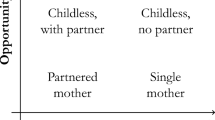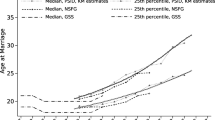Abstract
Evolutionary theory predicts that social status and fertility will be positively related. It also predicts that the relationship between status and fertility will differ for men and women. This is particularly likely in modern societies given evidence that females face greater trade-offs between status and resource acquisition and fertility than males. This paper tests these hypotheses using newly released data from the 2014 wave of the Survey of Income and Program Participation by the US Census, which has the first complete measures of fertility and number of childbearing partners for a large, representative, national probability sample of men and women and also contains comprehensive measures of economic status as measured by personal and family resources, including income from all sources and all assets. Multivariate analyses show that personal income is positively associated with total fertility and number of childbearing unions for men only. For men, personal net worth is positively associated with number of childbearing unions; it is also positively associated with fertility for married men with a spouse present. These findings support evolutionary predictions of a positive relationship between status, access to mates, and reproductive success for males. Whereas personal income and personal net worth are negatively associated with total fertility and number of childbearing unions for women, family income (net of personal income) is positively associated with total fertility for women. For married men living with a spouse, family income (net of personal income) is negatively associated with total fertility. These findings are consistent with evolutionary theory given the existence of greater trade-offs between production and reproduction for women in an advanced industrial society. For women and men, family net worth (net of personal net worth) is negatively associated with number of childbearing unions and fertility. Implications are discussed.
Similar content being viewed by others
Change history
15 June 2020
Because of an error in calculation of coefficients reported in the article ���Sex Differences in the Association of Family and Personal Income and Wealth with Fertility in the United States���.
References
Barthold, J. A., Myrskylä, M., & Jones, O. R. (2012). Childlessness drives the sex difference in the association between income and reproductive success of modern Europeans. Evolution and Human Behavior, 33(6), 628–638.
Bateman, A. J. (1948). Intrasexual selection in Drosophila. Heredity, 2, 349–368.
Belsley, D. A. (1982). Assessing the presence of harmful collinearity and other forms of weak data through a test for signal-to-noise. Journal of Econometrics, 20(2), 211–253.
Bereczkei, T., & Csanaky, A. (1996). Mate choice, marital success, and reproduction in a modern society. Etholgy and Sociobiology, 17, 17–36.
Borgerhoff Mulder, M. (1987a). On cultural and reproductive success: Kipsigis evidence. American Anthropologist, 89, 617–634.
Borgerhoff Mulder, M. (1987b). Resources and reproductive success in women, with an example from the Kipsigis. Journal of Zoology, 213, 489–505.
Borgerhoff Mulder, M. (2009). Serial monogamy as polygyny or polyandry? Marriage in the Tanzanian Pimbwe. Human Nature, 20, 130–150.
Borgerhoff Mulder, M. (2019) Bateman’s principles & the study of evolutionary demography. In O. Burger, R. Lee and R. Sear (Eds.), Human evolutionary demography. Retrieved 9/18/19 from https://osf.io/p59eu/.
Brewster, K. L., & Rindfuss, R. R. (2000). Fertility and women's employment in industrialized nations. Annual Review of Sociology, 26(1), 271–296.
Buss, D. M. (1989). Sex differences in human mate preferences: Evolutionary hypotheses tested in 37 cultures. Behavioral and Brain Sciences, 12, 1–49.
Buss, D. M. T., Shackelford, K., Kirkpatrick, L. A., & Larsen, R. J. (2001). A half century of mate preferences: The cultural evolution of values. Journal of Marriage and Family, 63(2), 491–503.
Coleman, D. A. (2000). Male fertility trends in industrial countries: Theories in search of some evidence. In C. Bledsoe, S. Lerner, & J. I. Guyer (Eds.), Fertility and the male life-cycle in the era of fertility decline (pp. 29–60). Oxford: Oxford University Press.
Colleran, H., Jasienska, G., Nenko, I., Galbarczyk, A., & Mace, R. (2015). Fertility decline and the changing dynamics of wealth, status and inequality. Proceedings of the Royal Society B, 282(1806), 20150287.
Craney, T. A., & Surles, J. G. (2002). Model-dependent variance inflation factor cutoff values. Quality Engineering, 14(3), 391–403.
DiPrete, T., Morgan, S. P., Engelhardt, H., & Pacalova, H. (2003). Do cross-national differences in the costs of children generate cross-national differences in fertility rates? Population Research and Policy Review, 22, 439–477.
Dye, J. L. (2008). Fertility of American women: June 2008. Current Population Reports, P20–563. Washington, DC: US Census Bureau.
Fieder, M., & Huber, S. (2007). The effects of sex and childlessness on the association between status and reproductive output in modern society. Evolution and Human Behavior, 28, 392–398.
Fieder, M., & Huber, S. (2012). An evolutionary account of status, power, and career in modern societies. Human Nature, 23, 191–207.
Fieder, M., Huber, S., & Bookstein, F. L. (2011). Socioeconomic status, marital status and childlessness in men and women: An analysis of census data from six countries. Journal of Biosocial Science, 43(5), 619–635.
Forsberg, A. J. L., & Tullberg, B. S. (1995). The relationship between cumulative number of cohabiting partners and number of children for men and women in modern Sweden. Ethology and Sociobiology, 16(3), 221–232.
Goodman, A., & Koupil, I. (2010). The effect of school performance upon marriage and long-term reproductive success in 10,000 Swedish males and females born 1915–1929. Evolution and Human Behavior, 31(6), 425–435.
Goodman, A., Koupil, I., & Lawson, D. W. (2012). Low fertility increases descendant socioeconomic position but reduces long-term fitness in a modern post-industrial society. Proceedings of the Royal Society of London B: Biological Sciences, 279(1746), 4342–4351.
Gowaty, P. A. (2004). Sex roles, contests for the control of reproduction, and sexual selection. In P. M. Kappeler & C. P. Van Schaik (Eds.), Sexual selection in primates: New and comparative perspectives (pp. 37–54). Cambridge: Cambridge University Press.
Guzzo, K. B. (2014). New partners, more kids: Multiple-partner fertility in the United States. Annals of the American Academy of Political and Social Science, 654(1), 66–86.
Guzzo, K. B., & Furstenberg, F. F. (2007). Multipartnered fertility among American men. Demography, 44(3), 583–601.
Henry, J., Helm Jr., H. W., & Cruz, N. (2013). Mate selection: Gender and generational differences. North American Journal of Psychology, 15(1), 63–70.
Hopcroft, R. L. (2006). Sex, status and reproductive success in the contemporary U.S. Evolution and Human Behavior, 27, 104–120.
Hopcroft, R. L. (2015). Sex differences in the relationship between status and number of offspring in the contemporary U.S. Evolution and Human Behavior, 36(2), 146–151.
Hopcroft, R. L., & Whitmeyer, J. M. (2010). A choice model of occupational status and fertility. Journal of Mathematical Sociology, 34(4), 283–300.
Hrdy, S. B. (2000). The optimal number of fathers: Evolution, demography, and history in the shaping of female mate preferences. In D. LeCroy and P. Moller (Eds.), Evolutionary perspectives on human reproductive behavior (pp. 75–96). Annals of the New York Academy of Sciences 907.
Huber, S., Bookstein, F. L., & Fieder, M. (2010). Socioeconomic status, education, and reproduction in modern women: An evolutionary perspective. American Journal of Human Biology, 22(5), 578–587.
Johnson, K. M., & Lichter, D. T. (2016). Diverging demography: Hispanic and non-Hispanic contributions to US population redistribution and diversity. Population Research and Policy Review, 35(5), 705–725.
Jokela, M., Rotkirch, A., Rickard, I. J., Pettay, J., & Lummaa, V. (2010). Serial monogamy increases reproductive success in men but not in women. Behavioral Ecology, 21(5), 906–912.
Joyner, K., Peters, H. E., Hynes, K., Sikora, A., Taber, J. R., & Rendall, M. S. (2012). The quality of male fertility data in major US surveys. Demography, 49(1), 101–124.
Judge, D. S. (1995). American legacies and the variable life histories of women and men. Human Nature, 6(4), 291–323.
Judge, D. S., & Hrdy, S. B. (1992). Allocation of accumulated resources among close kin: Inheritance in Sacramento, California, 1890–1984. Ethology and Sociobiology, 13(5–6), 495–522.
Kaplan, H. S., & Lancaster, J. B. (2003). An evolutionary and ecological analysis of human fertility, mating patterns, and parental investment. In K. W. Wachter & R. A. Bulatao (Eds.), Offspring: Human fertility behavior in biodemographic perspective (pp. 170–223). Washington, DC: National Academies Press.
Kaplan, H. S., Lancaster, J. B., Johnson, S. E., & Bock, J. A. (1995). Does observed fertility maximize fitness among new Mexican men? Human Nature, 6(4), 325–360.
Killewald, A. (2016). Money, work, and marital stability: Assessing change in the gendered determinants of divorce. American Sociological Review, 81(4), 696–719.
Lappegård, T., & Rønsen, M. (2013). Socioeconomic differences in multipartner fertility among Norwegian men. Demography, 50, 1135–1153.
Leupp, K. (2019). Bargaining bonus or breadwinning burden? Wives’ relative earnings, childrearing, and depression. Sociological Perspectives. https://doi.org/10.1177/0731121419842132.
Low, B. S., Simon, C. P., & Anderson, K. G. (2002). An evolutionary ecological perspective on demographic transitions: Modeling multiple currencies. American Journal of Human Biology, 14, 149–167.
Lumley, T., Diehr, P., Emerson, S., & Chen, L. (2002). The importance of the normality assumption in large public health data sets. Annual Review of Public Health, 23(1), 151–169.
Morgan, S. P. (1996). Characteristic features of modern American fertility. Population and Development Review, 22, 19–63.
Morgan, S. P. (2003). Is low fertility a twenty-first-century demographic crisis? Demography, 40(4), 589–603.
Nettle, D., & Pollet, T. V. (2008). Natural selection on male wealth in humans. The American Naturalist, 172(5), 658–666.
Nisén, J., Martikainen, P., Myrskylä, M., & Silventoinen, K. (2018). Education, other socioeconomic characteristics across the life course, and fertility among Finnish men. European Journal of Population, 34, 337.
Oppenheimer, V. K. (2000). The continuing importance of men’s economic position in marriage formation. In L. J. Waite et al. (Eds.), The ties that bind: Perspectives on marriage and cohabitation (pp. 283–301). New York: Aldine de Gruyter.
Potts, M. (1997). Sex and the birth rate: Human biology, demographic change, and access to fertility-regulation methods. Population and Development Review, 23(1), 1–39.
Ruggles, S. (2016). Marriage, family systems, and economic opportunity in the USA since 1850. In S. M. McHale, V. King, J. Van Hook, & A. Booth (Eds.), Gender and couple relationships (pp. 3–41). Cham: Springer International.
Rust, K. F., & Rao, J. N. K. (1996). Variance estimation for complex surveys using replication techniques. Statistical Methods in Medical Research, 5(3), 283–310.
Sainani, K. L. (2012). Dealing with non-normal data. PM&R, 4(12), 1001–1005.
Sayer, L. C., & Bianchi, S. M. (2000). Women’s economic independence and the probability of divorce. Journal of Family Issues, 21(7), 906–943.
Stockley, P., & Bro-Jørgensen, J. (2011). Female competition and its evolutionary consequences in mammals. Biological Reviews, 86(2), 341–366.
Stulp, G., & Barrett, L. (2016). Wealth, fertility and adaptive behavior in industrial populations. Philosophical Transactions of the Royal Society B, 371, 20150153.
Stulp, G., Sear, R., Schaffnit, S. B., Mills, M. C., & Barrett, L. (2016). The reproductive ecology of industrial societies, part II: The association between wealth and fertility. Human Nature, 27(4), 445–470.
Trivers, R. (1972). Parental investment and sexual selection. In B. Campbell (Ed.), Sexual selection and the descent of man, 1871–1971 (pp. 136–179). Chicago: Aldine de Gruyter.
Vining, D. R. (1986). Social versus reproductive success: The central theoretical problem of human sociobiology. Behavioral and Brain Sciences, 9(1), 167–187.
Wiederman, M. W., & Allgeier, E. R. (1992). Gender differences in mate selection criteria: Sociobiological or socioeconomic explanation? Ethology and Sociobiology, 13, 115–124.
Wilson, E. O. (1980). Sociobiology. Cambridge: Harvard University Press (Originally published in 1975).
Zhang, L. (2011). Male fertility patterns and determinants. Springer Series on Demographic Methods and Population Analysis 27. Dordrecht: Springer.
Author information
Authors and Affiliations
Corresponding author
Additional information
Publisher’s Note
Springer Nature remains neutral with regard to jurisdictional claims in published maps and institutional affiliations.
Rights and permissions
About this article
Cite this article
Hopcroft, R.L. Sex Differences in the Association of Family and Personal Income and Wealth with Fertility in the United States. Hum Nat 30, 477–495 (2019). https://doi.org/10.1007/s12110-019-09354-4
Published:
Issue Date:
DOI: https://doi.org/10.1007/s12110-019-09354-4




